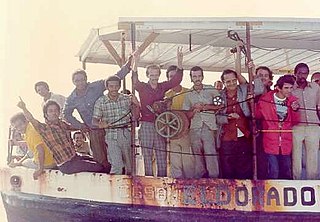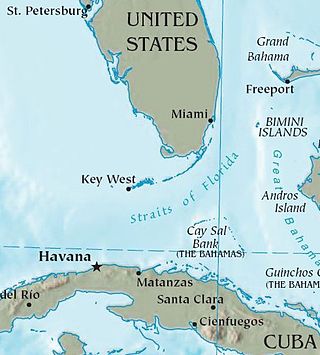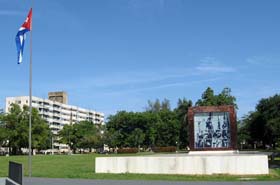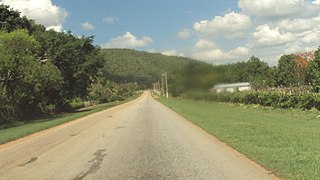Related Research Articles

The Mariel boatlift was a mass emigration of Cubans who traveled from Cuba's Mariel Harbor to the United States between April 15 and October 31, 1980. The term "Marielito" is used to refer to these refugees in both Spanish and English. While the exodus was triggered by a sharp downturn in the Cuban economy, it followed on the heels of generations of Cubans who had immigrated to the United States in the preceding decades.

Mariel Hadley Hemingway is an American actress. She began acting at age 14 with a Golden Globe-nominated breakout role in Lipstick (1976), and she received Academy and BAFTA Award nominations for her performance in Woody Allen's Manhattan (1979).

Bauta is a municipality and town located 40 km (25 mi) southwest of Havana City, in the Artemisa Province of Cuba since 2010 as a result of the division of what was the Province of Havana.

The Cuban exodus is the mass emigration of Cubans from the island of Cuba after the Cuban Revolution of 1959. Throughout the exodus, millions of Cubans from diverse social positions within Cuban society emigrated within various emigration waves, due to political repression and disillusionment with life in Cuba.
Mariel may refer to:

Artemisa is a municipality and city in Cuba, formerly part of La Habana Province. According to a law approved by the Cuban National Assembly in August 2010, Artemisa became the capital city of the newly formed Artemisa Province, which comprises eight municipalities of the former La Habana Province and three from Pinar del Río. It has an area of 642.0 square kilometers and a population of over 85,000 inhabitants (2017).
The Atlanta prison riots were a series of prison riots that occurred at the U.S. Penitentiary in Atlanta, Georgia, United States in November 1987. The riot coincided with a similar riot at the Federal Detention Center in Oakdale, Louisiana.

Caimito is a municipality and town in Artemisa Province of Cuba. The town was founded in 1820. The municipality of Caimito del Guayabal was created in 1910, based on the previously existing (1879–1902) municipality of Guayabal in the Pinar del Río Province. Since 1976, the official name is Caimito.

Mariel is a municipality and town in the Artemisa Province of Cuba. It is located approximately 40 kilometres (25 mi) west of the city of Havana.

Playa Baracoa, sometimes shortened as Baracoa, is a Cuban village and consejo popular of the municipality of Bauta, in Artemisa Province. In 2011 it had a population of about 7,000.

The road network of Cuba consists of 60,858 km (37,815 mi) of roads, of which over 29,850 km (18,550 mi) are paved and 31,038 km (19,286 mi) are unpaved. The Caribbean country counts also 654 km (406 mi) of motorways (autopistas).
Marielitos is the name given to the Cuban immigrants that left Cuba from the Port of Mariel in 1980. Approximately 135,000 people left the country to the United States from April to September in what became known as the Mariel boatlift.
Carlos Alfonzo (1950–1991) was a Cuban-American painter known for his neo-impressionistic style. His work has been collected by Whitney Museum of American Art and Smithsonian Institution.

The Circuito Norte (CN), meaning "Northern Circuit", is a west-east highway spanning the length of the island of Cuba, through the Atlantic Coast. With a length of 1,222 km, it is the second-longest Cuban highway, after the "Carretera Central"; and two sections of it, named "Vía Blanca" and "Panamericana", are classified as Expressways.

The Autopista Havana–Mariel, also known as Carretera Panamericana, is a Cuban motorway linking Havana to Mariel. It is a toll-free road and has a length of 26 km (16 mi). Even though it is a motorway (autopista), it is part of the national highway Circuito Norte (CN).

Hospital de San Lázaro was a hospital in the city of Havana, Cuba. It dates back to the 17th century, when it served as headquarters for some huts built near the Caleta de Juan Guillén, then known as Caleta de San Lázaro, in an area about a mile outside the city walls.
The Fort Chaffee crisis occurred during the Mariel boatlift in 1980 when over 19,000 Cuban refugees were detained at Fort Chaffee. They could not be released into the public because they were not United States citizens. After a promise of quick release many processing setbacks occurred and many refugees remained still detained at the center. Frustrated with the conditions at the facility and the slow processing many refugees rioted, 62 refugees were injured and 46 others were arrested. Refugees at the center would go on to refer to the riot as El Domingo. After the riots Governor Bill Clinton put heavy fortifications at the center. Clinton would lose the later Arkansas election after his opponent would use the incident against him.

A Cuban exile is a person who emigrated from Cuba in the Cuban exodus. Exiles have various differing experiences as emigrants depending on when they migrated during the exodus.

On April 1, 1980, six Cuban citizens made their way into the Peruvian embassy in Havana, Cuba, instigating an international crisis over the diplomatic status of around 10,000 asylum-seeking Cubans who joined them over the following days. The Peruvian ambassador, Ernesto Pinto Bazurco Rittler, spearheaded the effort to protect Cubans, most of whom were disapproved of by Fidel Castro’s regime and were seeking protection at the embassy. This episode marked the start of the Cuban refugee crisis, which was followed by a series of diplomatic initiatives between various countries in both North and South America that tried to organize the fleeing of people from the island of Cuba to the United States and elsewhere. The embassy crisis culminated with the substantial exodus of 125,266 Cuban asylum-seekers during the Mariel Boatlift.